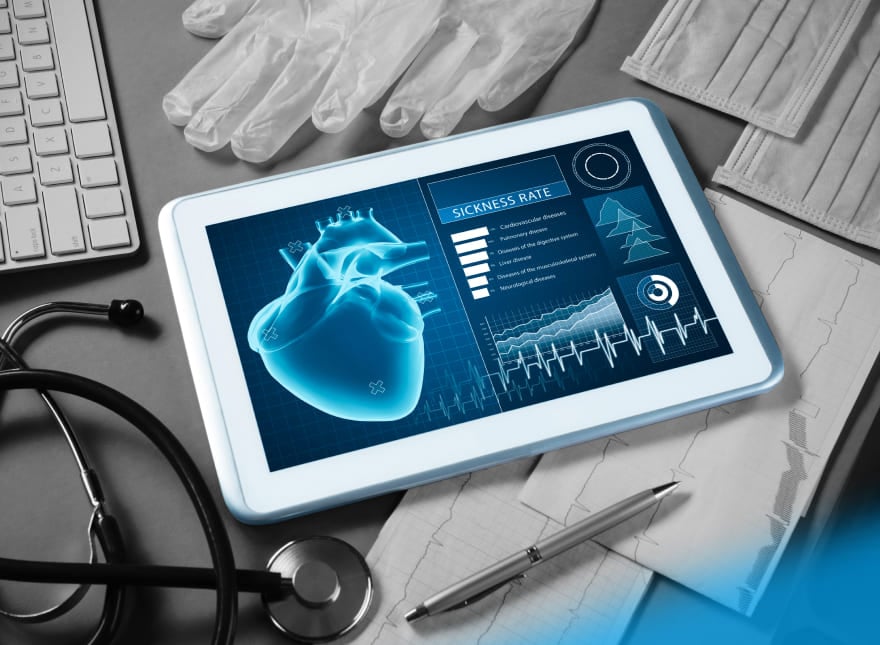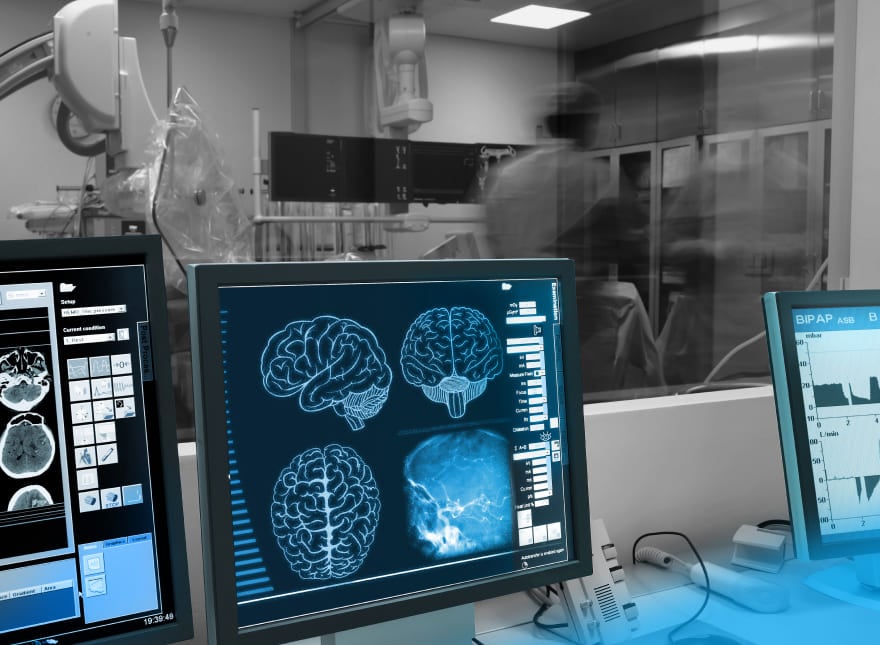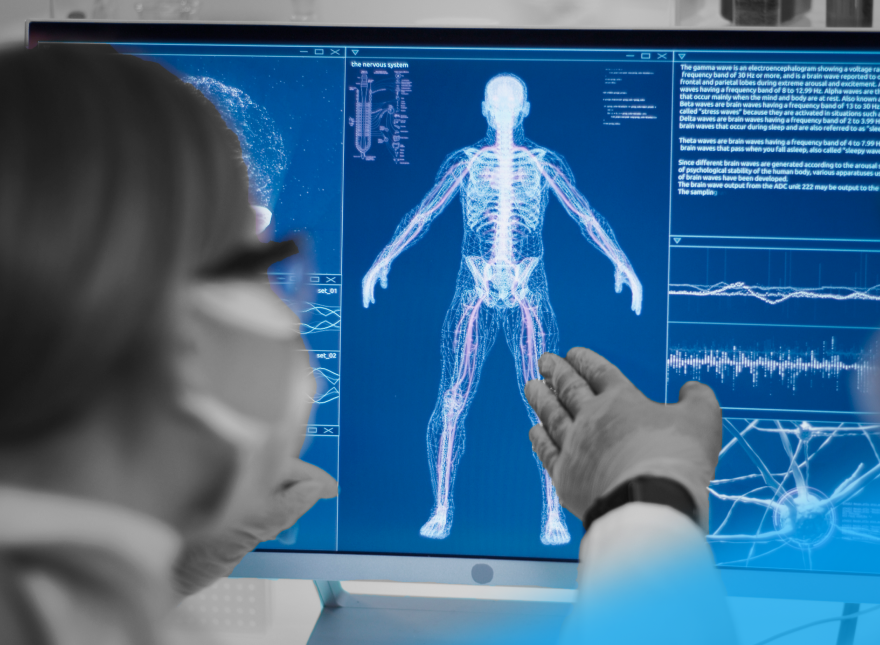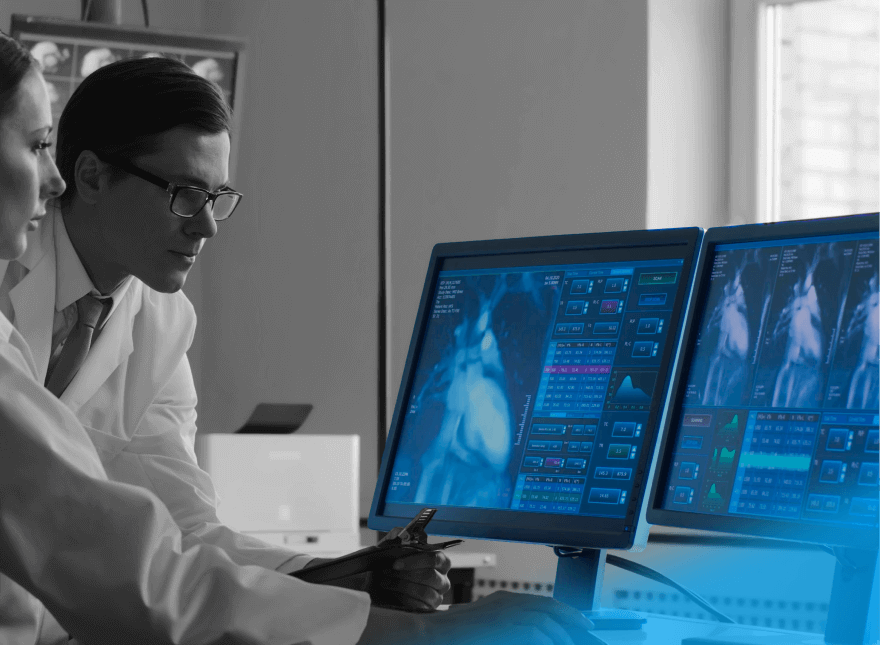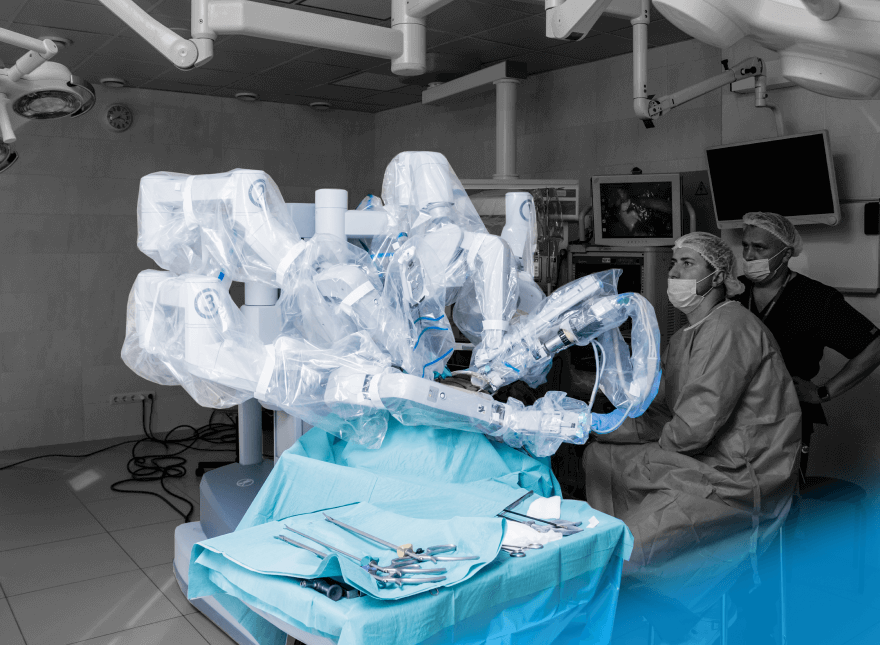Business Opportunities in Health IoT: Edge Computing and AI for Connected Devices
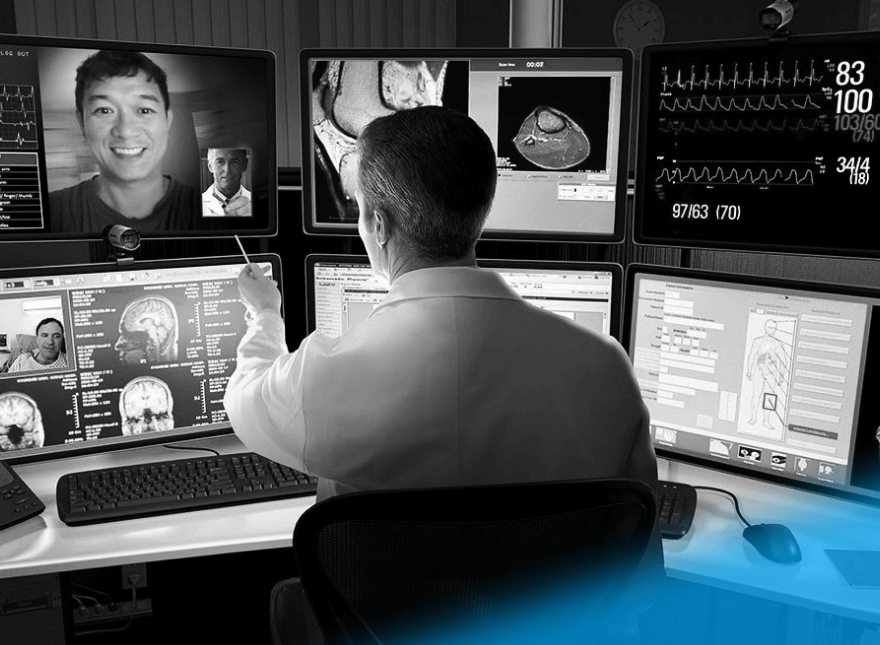
Booming markets create favorable circumstances for both startups and established businesses. We've prepared an overview of opportunities in health IoT for product companies and software integrators. It's based on a study developed by Parks Associates for Softeq. The full report is available after filling out the form below.
Table of Contents
So, let’s see how virtual care struggles to encompass multiple aspects of healthcare and how digital health companies can ease the strain on care professionals and their patients.
State of the Market
Digital health transformation has been a slowly developing trend for several decades but the pandemic has accelerated the process. Within the span of several months, the industry underwent up to ten years’ worth of changes. Because of the COVID-19 lockdown, virtual care has shown itself to be a lifesaver to all stakeholders—from care providers to patients to insurers.
Telehealth
Let’s look at the change in numbers of telehealth users. In May 2019, only 15% of US households with broadband access to the Internet had a telehealth experience. But in May 2020, that share showed almost a three-fold increase: nearly each second household had used telehealth services by that time. Within a couple of months of the pandemic, telehealth had transformed from a rarely used service into a common practice. This became possible mainly due to the CARES Act—the Coronavirus Aid, Relief, and Economic Security Act released by the AMA. Among other things, it encouraged federal, state, and private insurance companies to extend their coverage on telehealth services.
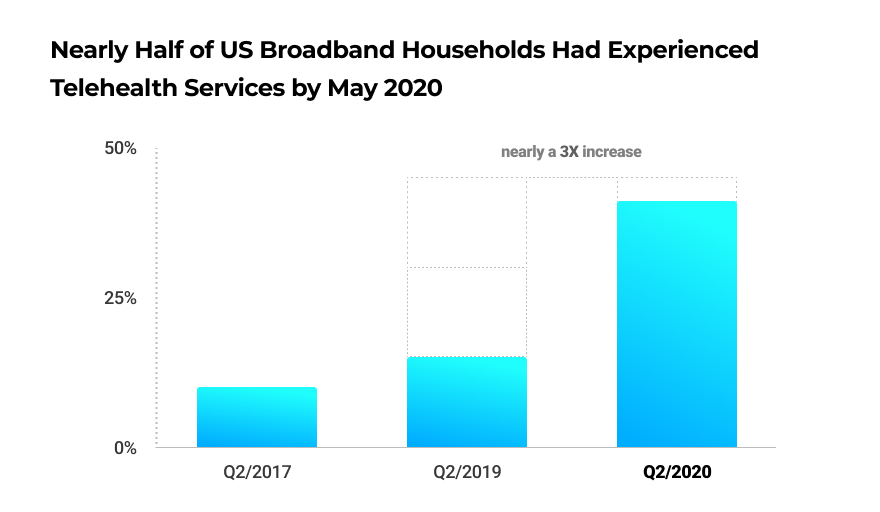
Besides the initial boosting effect of new healthcare policies, perhaps of equal or even more importance for further digital health market development is a high level of consumer satisfaction. According to McKinsey COVID-19 Consumer Survey, three out of four users found their telehealth experience greatly satisfying. This means that in the future, such consumers are very unlikely to return to offline in-person visits without absolute necessity.
Remote Patient Monitoring
Virtual care isn’t limited to telehealth alone: another crucial digital health service is remote health monitoring. Connected medical products are very diverse and vary from connected health devices to wearables. They allow providers to collect health data on their patients remotely—whether tracking the state of a patient after surgery in the hospital or monitoring vitals on someone at their own home. The latter situation became especially common in the last year, generating demand for consumer electronics able to collect health data.
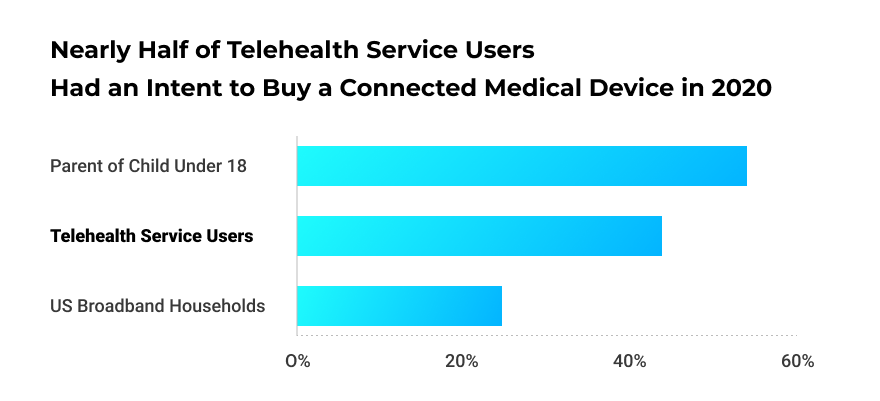
The diagram shows three major factors contributing to interest in consumer health tracking devices. We see that simply having broadband Internet connection isn't sufficient for generating an active interest in health data, even if it's necessary for in-home sensor-based safety- and health-tracking systems.
But among current telehealth users (with seniors as the most enthusiastic group of users), not to mention families with children, the situation already looks very promising. Nearly each second person in these groups is ready to purchase connected health devices. And for 64% of device owners and 43% of non-owners, one of the most appealing features of such trackers is the possibility to share the collected data with friends, relatives, and care providers.
This reveals a huge demand for not only health device integration, but also new products and services from both healthcare institutions and consumers.
Demand for Customized Well-integrated Solutions
Even in the post-pandemic world, with such a high level of consumer expectations, healthcare institutions can't remain oblivious to healthcare digitalization. By ignoring the demand for virtual care services, care providers will lose out to their more flexible competitors. And now, while the pandemic is still ongoing, the nature of the losses can be even more severe. Let’s consider the main challenges on the way to digital transformation:
- At the moment, the most developed virtual care service is telehealth. But telehealth alone in many cases can't provide sufficient care. To give a worthwhile consultation, physicians need to consider multiple forms of health data: clinical tests, vitals from wearables, connected medical device monitoring data, and others. All this data comes from scattered sources and can hardly be gathered in one place for each patient. The interpretation of such data takes a lot of time and can be done only by humans without any prospect for process optimization
- The other difficulty lies in the fact that many healthcare institutions have their own unique IT infrastructure: EHR/EMR platforms, as well as billing and clinical systems. Updating unique systems and adding new services to them is always more effort-consuming and costly than doing the same with standardized platforms and services
The most optimal solution to these obstacles is to use new off-the-shelf virtual care solutions that are able to integrate data from the most common sources. A professional software/system integrating company can help customize this new off-the-shell virtual care solution and integrate it into the existing infrastructure. This approach is much more cost-efficient than trying to create another unique system. The industry is developing too fast for healthcare institutions to afford to develop new solutions on an as-needed basis. A ready-to-use end-to-end solution supported by a specialised software development company is much easier to maintain, use, and scale.
Demand for Innovative Products and Services
Major Challenges
Even if current digital telehealth solutions are becoming a must for healthcare institutions, they leave much to be desired. The main problem of existing telemedicine services lies in limited use cases: they're geared for remote consultations only. And this is absolutely insufficient for the existing needs of the population. The biggest challenge is that current solutions don’t allow for collecting clinical testing data and vitals. Thus, there's no possibility for monitoring patients with higher risks of complications or chronic diseases, or those requiring pre- and post-surgery health data tracking.
This situation may seem surprising, since remote patient monitoring solutions exist and are in high demand among care professionals. But connected health devices are still siloed in terms of communication with other healthcare systems. Most frequently, their data on a particular patient can't be gathered together and accessed from a single place. Additionally, many existing remote monitoring solutions have had multiple issues with user experience. Thus, connecting medical devices for data collection is a tough task in many aspects.
When it comes to using consumer electronics—health data tracking devices—by patients, the complications continue. To share device data with a physician, patients have to generate in-app reports (or create them manually) and send them to the doctor by email. Physicians in their turn can only read these reports—there's currently no option to integrate reports from scattered devices into EHRs to see the general picture and look for trends or insights. Thus, for patients, sharing data is complicated, and for doctors, seeing data in context is even harder. Both issues are a speedbump for efficient care.
New Solutions
Augmenting virtual consultation platforms with the patient’s health data is currently one of the main challenges for virtual care. There're two directions to go:
- Building intelligent and well-integrated services for remote consultations that allow for integration with medical devices to ensure that a care professional takes into account all the available health data for each patient for providing better care
- Building consumer intuitive health IoT solutions that gather health data from in-home IoT devices
The intelligence of such solutions means that monitoring services take responsibility for initial health data interpretation on themselves and escalate it to care providers only on an as-needed basis. Changes in reimbursement policies support this shift of responsibilities, and innovative technologies make this shift possible.
Innovative Technologies
Technologically, such innovative solutions become possible with the help of edge computing, artificial intelligence, and machine learning in particular. For example, edge computing allows for building systems that can combine data from several sources locally to verify changes in health metrics across all the relevant connected devices and only then notify clinicians about an emergency.
Artificial intelligence is even more powerful: it can see new health data on one patient in the context of all historical health data of millions of patients. For example, ML-based solutions can pair data on each particular patient with a huge dataset containing billions of rows of health records, vitals, clinical tests, and pictures. This allows doctors to identify the patient’s trajectory, compare it with similar trajectories of other patients, and predict critical states even if there're no other signs of what’s coming.
If combined, AI and edge computing can change the concept of virtual care completely. For example, it becomes possible to build intelligent in-home overall solutions for seniors living independently. Sensors will monitor health metrics and daily activities, while virtual assistants will encourage elders to perform exercises, follow their medication plans, and arrange a telehealth consultation with a care provider if necessary. The cherry on top will be integration of such in-home health IoT solutions with clinical systems.
Next Evolution of Health IoT: Moving Towards the Edge (Industry Report)
Deeper device data integration for more complex virtual care
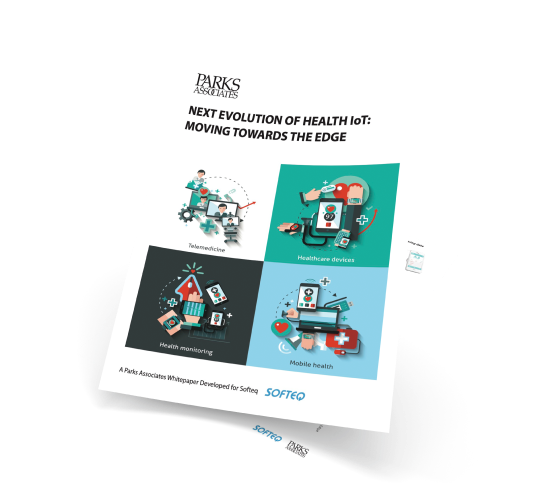
The Bottom Line
Now and in many situations in the future there's a choice between remote healthcare and no healthcare at all. And this generates the huge demand for digital health infrastructure and IoT solutions from both patients and care providers. This is a huge opportunity and challenge for product companies and startups struggling to enter the market with their solutions. And there's a big demand for skillful and agile software and system integrators to customize the existing and emerging solutions and integrate them with existing healthcare services at hospitals and homes.
More articles on the topic

